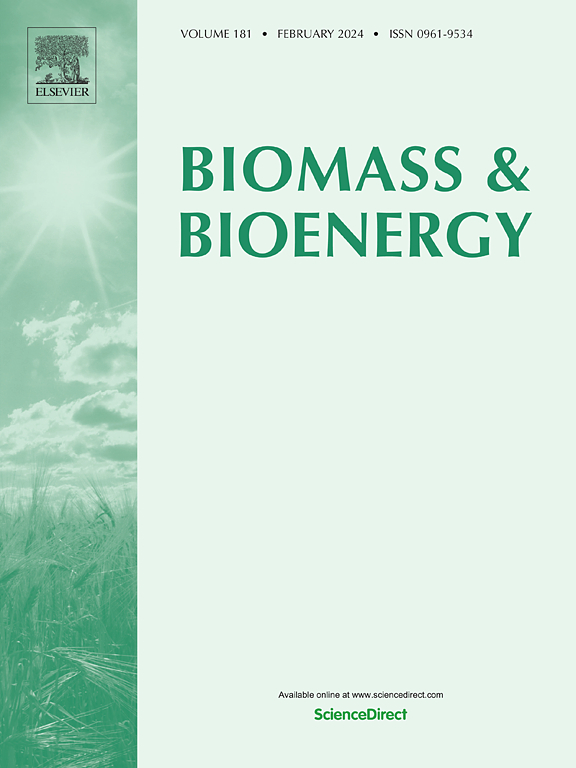Hydrothermal reduction of CO2 into formate in a semicontinuous plant with soft wood as reducing agent
IF 5.8
2区 生物学
Q1 AGRICULTURAL ENGINEERING
引用次数: 0
Abstract
There is a growing interest in producing valuable products from renewable materials such as biomass and CO2. One of the current challenges in this field is developing processes that can be scaled up to match the large volumes of CO2 emissions. In this study, a process is developed that consists of the simultaneous conversion of biomass and reduction of CO2 into formic acid in hydrothermal media. Experimental results from a semi-continuous plant, using NaHCO3 as inorganic CO2 source and soft wood as biomass reducing agent, are presented. In addition to formic acid, the other main products are acetic acid and lactic acid. Nuclear Magnetic Resonance analyses revealed that acetic acid and lactic acid are derived exclusively from the oxidation of biomass, while formic acid is the main product originating from the inorganic carbon source. It was determined that at 300 °C, 37 % of the total production of formic acid comes from the reduction of inorganic CO2. Experiments with ramp heating with temperature increments of 5 °C/min showed that low reaction temperatures (150, 200 °C) favor the production of acetic acid from biomass, while higher temperatures (300 °C) promote the production of formic acid and lactic acid from both biomass and CO2. According to these results, a staged heating can lead to a fractionation of these products. These results validate the hydrothermal reduction technology for the scalable, semicontinuous conversion of CO2 using lignocellulosic biomass reductants, and offer a new approach for the downstream processing of the effluent, based on a prior fractionation in the reactor.
以软木材为还原剂在半连续装置中水热还原CO2为甲酸盐
人们对利用生物质和二氧化碳等可再生材料生产有价值的产品越来越感兴趣。这一领域目前面临的挑战之一是开发可以扩大规模以匹配大量二氧化碳排放的工艺。在本研究中,开发了一种在水热介质中同时转化生物质和将CO2还原为甲酸的工艺。介绍了以NaHCO3为无机CO2源,软木材为生物质还原剂的半连续装置实验结果。除甲酸外,其他主要产品有乙酸和乳酸。核磁共振分析表明,乙酸和乳酸完全来源于生物质氧化,而甲酸是主要来源于无机碳源的产物。经测定,在300℃时,甲酸总产量的37%来自无机CO2的还原。升温幅度为5°C/min的斜坡加热实验表明,较低的反应温度(150°C、200°C)有利于生物质生成乙酸,而较高的温度(300°C)有利于生物质和CO2生成甲酸和乳酸。根据这些结果,阶段加热可以导致这些产品的分馏。这些结果验证了使用木质纤维素生物质还原剂可扩展、半连续转化二氧化碳的水热还原技术,并为基于反应器中优先分馏的废水下游处理提供了一种新方法。
本文章由计算机程序翻译,如有差异,请以英文原文为准。
求助全文
约1分钟内获得全文
求助全文
来源期刊

Biomass & Bioenergy
工程技术-能源与燃料
CiteScore
11.50
自引率
3.30%
发文量
258
审稿时长
60 days
期刊介绍:
Biomass & Bioenergy is an international journal publishing original research papers and short communications, review articles and case studies on biological resources, chemical and biological processes, and biomass products for new renewable sources of energy and materials.
The scope of the journal extends to the environmental, management and economic aspects of biomass and bioenergy.
Key areas covered by the journal:
• Biomass: sources, energy crop production processes, genetic improvements, composition. Please note that research on these biomass subjects must be linked directly to bioenergy generation.
• Biological Residues: residues/rests from agricultural production, forestry and plantations (palm, sugar etc), processing industries, and municipal sources (MSW). Papers on the use of biomass residues through innovative processes/technological novelty and/or consideration of feedstock/system sustainability (or unsustainability) are welcomed. However waste treatment processes and pollution control or mitigation which are only tangentially related to bioenergy are not in the scope of the journal, as they are more suited to publications in the environmental arena. Papers that describe conventional waste streams (ie well described in existing literature) that do not empirically address ''new'' added value from the process are not suitable for submission to the journal.
• Bioenergy Processes: fermentations, thermochemical conversions, liquid and gaseous fuels, and petrochemical substitutes
• Bioenergy Utilization: direct combustion, gasification, electricity production, chemical processes, and by-product remediation
• Biomass and the Environment: carbon cycle, the net energy efficiency of bioenergy systems, assessment of sustainability, and biodiversity issues.
 求助内容:
求助内容: 应助结果提醒方式:
应助结果提醒方式:


